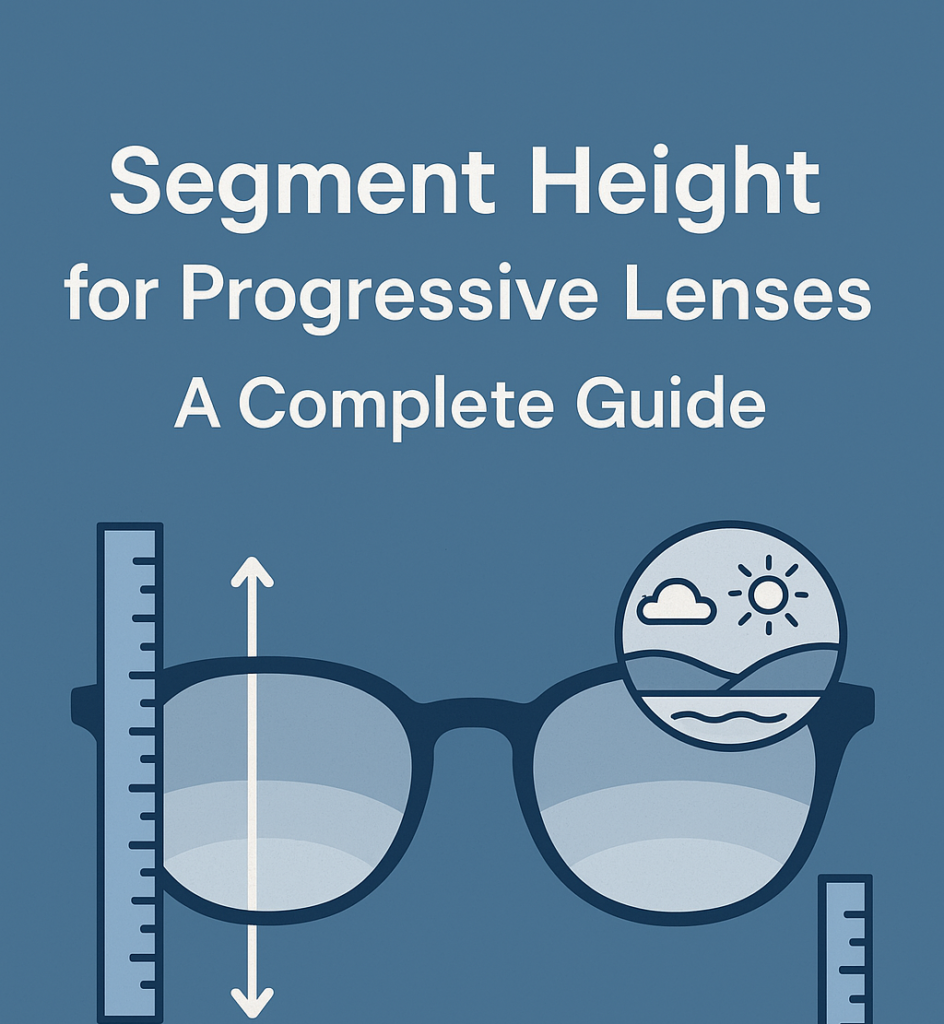If you’re new to progressive lenses or simply seeking clarity on how they’re customized for perfect vision, you’ve probably encountered the term “segment height“. Understanding and measuring segment height correctly is crucial for optimal vision comfort and effectiveness of your progressive lenses. In this guide, we’ll explore what segment height is, why it’s important, and how you can accurately measure it.
What is Segment Height in Progressive Lenses?
Segment height refers to the vertical measurement from the bottom of your eyeglass frame to the point where the progressive lens begins transitioning from distance vision to intermediate and near vision. It ensures your lenses provide clear vision at all distances—far, intermediate, and near—through accurately positioned optical zones.
Progressive lenses, often called no-line bifocals, contain multiple optical strengths within a single lens. Unlike traditional bifocals or trifocals with visible lines, progressive lenses offer seamless vision correction at varying distances. Segment height is integral in tailoring these lenses specifically to your eyesight and the frame you choose.
Why Is Accurate Segment Height Measurement Essential?
An improperly measured segment height can lead to:
- Blurred or distorted vision
- Uncomfortable head and neck positioning
- Eye strain or fatigue
- Difficulty adjusting to your lenses
Ensuring an accurate segment height measurement is key to enjoying clear vision at every range without discomfort.
How to Measure Segment Height Correctly
While your optician or eyewear professional usually measures segment height accurately during fitting sessions, it’s useful to know the process. Here’s a simplified way to understand the procedure:
Step-by-Step Segment Height Measurement
- Wear Your Chosen Frames
- Ensure frames are positioned comfortably on your face exactly how you’d typically wear them.
- Keep a Natural Posture
- Maintain a natural, upright head and neck posture, looking straight ahead.
- Mark the Reference
- Have an optician (or friend) mark a small dot directly over your pupil on the lens of your frames, keeping your gaze straight forward at eye level.
- Measure the Height
- Using a millimeter ruler, measure vertically from the very bottom inner edge of your eyewear frame up to the marked dot.
These measurements typically range from 14 mm to 25 mm, depending on your frames and facial anatomy.
Quick Tip: Using digital measurement tools like Optigrid can help simplify this process by accurately analyzing images of your face and frames for precise measurements.
Common Mistakes and How to Avoid Them
When measuring segment height, avoid these frequent mistakes:
- Incorrect Posture: Leaning forward or backward skews measurements. Always maintain a comfortable, natural position.
- Improper Frame Placement: Ensure your frame sits correctly on your nose and ears before marking.
- Ignoring Frame Shape: Segment height varies with frame designs; larger frames usually have higher segment height measurements.
Segment Height vs. Pupillary Distance (PD): What’s the Difference?
While related, segment height differs from Pupillary Distance (PD):
- Segment Height: Vertical measurement from frame bottom to pupil (lens positioning vertically).
- Pupillary Distance (PD): Horizontal measurement between the center of your pupils (lens positioning horizontally).
Both measurements ensure your progressive lenses align perfectly with your eyes. For a deeper dive, check out our comprehensive PD measurement guide.

Choosing the Right Frames for Progressive Lenses
Some frames complement progressive lenses better. Ideal frames generally have:
- Moderate lens height (at least 28mm vertically recommended for smooth progression zones)
- Stability and comfortable fit
- Minimal lens curvature or wrap-around style to avoid distortion
For helpful tips on choosing eyewear, see Consumer Reports’ Guide to Eyeglass Frames to ensure you select frames suitable for your vision needs.
Optimizing Vision Comfort with Segment Height Adjustment
Even perfect initial measurements might require fine-tuning. If you experience discomfort after receiving your glasses:
- Visit your optician promptly to reassess and adjust segment height.
- Allow sufficient adaptation time (typically 1-2 weeks) for new progressive wearers.
- Avoid frequently switching between old and new glasses during the adaptation phase.
Final Thoughts
Accurate segment height measurement is crucial for optimal vision with progressive lenses. Understanding the basics of segment height can empower you to communicate effectively with your eyewear provider and enjoy comfortable, clear vision at every distance.
If you’re looking for precise segment height and PD measurement solutions for eyewear professionals or consumers, try our advanced and easy-to-use measurement platform Optigrid.
Further Reading & Helpful Resources

I am a seasoned software engineer with over two decades of experience and a deep-rooted background in the optical industry, thanks to a family business. Driven by a passion for developing impactful software solutions, I pride myself on being a dedicated problem solver who strives to transform challenges into opportunities for innovation.

